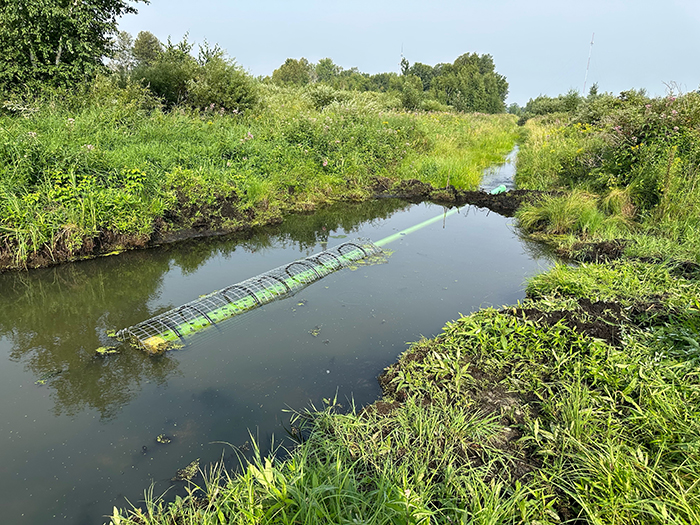OTC brings innovative solution to blocked drainage ditches
News | Published on August 22, 2023 at 2:57pm GMT+0000 | Author: Tucker Henderson
0
The Clemson Leveler effectively reduces flooding in certain situations, such as a beaver dam built in a culvert or a dam constructed at the outlet of a small pond. Once installed, the leveler is virtually maintenance-free.
Otter Tail County’s Ditch and Drainage Systems team had a recurring problem: beavers continued to build dams that blocked drainage ditches in the County. The County’s Drainage Inspector, Colby Palmersheim, was determined to find an innovative solution. So, he built one: a Clemson Beaver Pond Leveler.
“We have been basically trapping beaver and removing dams from drainage ditches continuously for the last two years, only for them to be built back up within two weeks,” said Palmersheim. “The trapping starts at about $150.00-200.00, and more if numerous beavers are trapped. The dam removal cost starts at about $600.00, depending on size, terrain for equipment, and distance for the contractor to travel.”
Clemson University in South Carolina created the device. According to the South Carolina Department of Aquaculture, Fisheries, and Wildlife, the Clemson Beaver Pond Leveler was developed to mitigate flooding while allowing the beavers to exist in their natural habitat. “The pond leveler intake device is designed to minimize the probability that current flow can be detected by beavers, therefore minimizing dam construction. When the outlet end of the leveler assemblage can be below water on the downstream side of a dam, problems should not develop.” (Cooperative Extension Service Clemson University, March 1994).
“With this device, the beavers should be able to continue to live in their habitat, and the idea is that they can’t figure out how the water is draining through the dam and will hopefully make the best of it, and we won’t need to focus so much time and money on this area,” Palmersheim said.
The Minnesota Department of Natural Resources has tested the Clemson Leveler and “determined it can effectively reduce flooding in certain situations, such as a beaver dam built in a culvert or a dam constructed at the outlet of a small pond. Once installed, the leveler is virtually maintenance-free.”
Using Clemson University’s material list and design, Palmersheim began working on the solution. He described the cost and process, “The Schedule 35 PVC pipes, adaptors, and other materials totaled $1,509.00 and took about 10 hours to build and install.” The pipe is set on ditch grade with a slight slope and, in theory, will level both sides of the dam.
Palmersheim highlights the innovative solution and the fiscal responsibility considered in the project. “I figure it would have been another $850.00 to remove the dam currently in place, and if we make it through the year with this working, the ditch will be money ahead.”
Under Minnesota State Statute, Palmersheim’s team is responsible for moving towards a more proactive approach in ensuring that the drainage system infrastructure is maintained and improved to better serve Otter Tail County.
“There is one other spot that has a similar device running through a culvert, but this is the first one we have installed through a dam, to my knowledge,” said Palmersheim. “If this stays functioning, I may build a few over the winter to have on hand for next season.”
MN State Statute 103E enforces the administration of drainage in Minnesota. In Otter Tail County, 60 County Drainage Ditch Systems were created under this Statute to improve drainage across the County. These systems were established and built between 1900 and 1923 due to public requests for these systems to be created. These 60 systems are a combination of 325 miles of open channel and tile drainage infrastructure designed to improve/increase farming capabilities, create outlets for landlocked water bodies, and drain nuisance wetlands that were considered a detriment to public health. For more information, visit the County’s drainage webpage ottertailcounty.gov/department/ditches-and-drainage-systems

